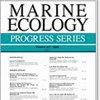Ontogenetic shifts in isotope-inferred trophic ecology of Atlantic bluefin tuna Thunnus thynnus in Atlantic Canada
IF 2.1
3区 环境科学与生态学
Q2 ECOLOGY
引用次数: 0
Abstract
ABSTRACT: Upper trophic level predators can greatly influence the dynamics and productivity of forage fish species. Quantifying this influence requires information on prey consumption; however, establishing feeding habits of highly mobile predators is particularly challenging. Stable isotopes of carbon and nitrogen (δ13C and δ15N) have been applied to characterize the trophic ecology of Atlantic bluefin tuna Thunnus thynnus (ABFT) in several important regions; however, applications in Canada are lacking. Here, we used δ13C and δ15N values of ABFT muscle tissue collected in 2014-2018 on 2 important foraging grounds along the coast of Atlantic Canada to evaluate the temporally integrated trophic ecology of this ecologically and commercially important species. Populations of some small pelagic fish species in these areas have been depleted, and predation by ABFT is considered a potentially important contributor. Isotopic diet reconstructions found that Atlantic mackerel were the dominant prey in the southern Gulf of St. Lawrence, and a combination of Atlantic herring and sandlance were the most dominant prey consumed on the Scotian Shelf. Diet reconstructions identified an ontogenetic shift in prey consumption, with more sandlance consumed by smaller ABFT and a shift to higher consumption of Atlantic mackerel and Atlantic herring as fish increased in size. Isotopic niche overlap indicated relatively high overlap for adults among years, suggesting that ABFT did not show substantial inter-annual variation in their trophic ecology. Overall, the study provides insight into the trophic ecology of ABFT along the Atlantic Coast of Canada that can be integrated into investigations of predator impacts on depleted mackerel and herring populations.加拿大大西洋蓝鳍金枪鱼(Thunnus thynnus)同位素推断营养生态学的世代变化
摘要:上层营养级捕食者会极大地影响饲料鱼类的动态和生产力。量化这种影响需要有关猎物消耗的信息;然而,确定高移动性捕食者的摄食习惯尤其具有挑战性。碳和氮的稳定同位素(δ13C 和 δ15N)已被用于描述大西洋蓝鳍金枪鱼(ABFT)在几个重要地区的营养生态学特征;然而,在加拿大却缺乏应用。在此,我们利用2014-2018年在加拿大大西洋沿岸2个重要觅食地采集的大西洋蓝鳍金枪鱼肌肉组织的δ13C和δ15N值,对这一具有重要生态和商业价值的物种的时间综合营养生态学进行了评估。这些地区的一些小型中上层鱼类种群已经枯竭,ABFT的捕食被认为是潜在的重要原因。同位素饮食重建发现,大西洋鲭鱼是圣劳伦斯湾南部的主要猎物,大西洋鲱鱼和沙鲽是斯科舍大陆架最主要的猎物。膳食重建确定了猎物消耗的个体发育转变,较小的ABFT消耗更多的沙鲽,随着鱼体的增大,大西洋鲭鱼和大西洋鲱鱼的消耗量增加。同位素生态位重叠表明,成鱼在不同年份之间的重叠率相对较高,这表明ABFT在其营养生态学方面并未表现出实质性的年际变化。总之,该研究提供了对加拿大大西洋沿岸ABFT营养生态学的见解,可用于调查捕食者对枯竭的鲭鱼和鲱鱼种群的影响。
本文章由计算机程序翻译,如有差异,请以英文原文为准。
求助全文
约1分钟内获得全文
求助全文
来源期刊

Marine Ecology Progress Series
环境科学-海洋学
CiteScore
5.30
自引率
8.00%
发文量
238
审稿时长
3 months
期刊介绍:
The leading journal in its field, MEPS covers all aspects of marine ecology, fundamental and applied. Topics covered include microbiology, botany, zoology, ecosystem research, biological oceanography, ecological aspects of fisheries and aquaculture, pollution, environmental protection, conservation, and resource management.
 求助内容:
求助内容: 应助结果提醒方式:
应助结果提醒方式:


